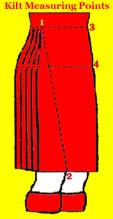One – Choose your tartan
 You may already know which tartan you would like to wear, or you may need some guidance. If you have an inkling – check the tartan finder to determine which exact tartan you would like. If you are not sure which tartan you could wear, visit our FAQ’s page for some guidance or you can always contact us for assistance in finding an appropriate tartan for you. We work with several different mills to bring you the best possible selection. Our tartan selection includes all registered tartans. Any tartan that is not readily available can be custom woven for you. We can also obtain Irish and Welsh Tartans. All tartan orders are non-refundable.
You may already know which tartan you would like to wear, or you may need some guidance. If you have an inkling – check the tartan finder to determine which exact tartan you would like. If you are not sure which tartan you could wear, visit our FAQ’s page for some guidance or you can always contact us for assistance in finding an appropriate tartan for you. We work with several different mills to bring you the best possible selection. Our tartan selection includes all registered tartans. Any tartan that is not readily available can be custom woven for you. We can also obtain Irish and Welsh Tartans. All tartan orders are non-refundable.
The traditional man’s kilt is made from an 8-yard length of tartan.
There are three styles of pleating:
- Dress – Pleated to the sett of the tartan. The pattern of the tartan is reproduced on the back pleats.
- Military – Pleated to the stripe. The predominanat stripe is centered on each pleat.
- Box Pleat – Old style military pleating.
Weight of the tartan:
The weight of the tartan refers to the thickness of the yarn used to weave the cloth. The thicker the yarn, the wider the sett, and the heavier the cloth.
A standard dress kilt can be made using:
- Medium weight 13oz material.
- Heavier weight 16oz-18oz offers a heavier and more durable garment.
- Light weight 11oz material is also offered, but is generally not recommended for a traditional kilt as it may be too lightweight to provide the proper “swing” of the kilt.
Two – Choose your style. What look are you going for?
 |
 |
 |
a. Formal with full 8-yard kilt, Prince Charlie Jacket, Waiscoat, Formal sporran and Belt, Hose and Flashes, Gillie Brogues
b. Semi formal – full kilt or casual/leisure kilt, waistcoat, Tweed kilt jacket, Day sporran and belt, hose and flashes
c. Casual with a 4-5 yard kilt that may be worn with a men’s dress shirt, Jacobite or Poet’s shirt, or a t-shirt, Day sporran and belt,
d. Are you a Piper or Dancer looking for a specific uniform or outfit?
Three – Choose how you want the kilt to be pleated.
 To the Sett or to the Stripe? Pleating to the stripe is often seen as a military or regimental setting. Not all tartans work well pleated to the stripe.
To the Sett or to the Stripe? Pleating to the stripe is often seen as a military or regimental setting. Not all tartans work well pleated to the stripe.
A kilt that is pleated to the stripe will have one stripe on every pleat as seen in the picture to the left. (Tartan shown in the Leslie, Hunting, Modern)
Four – Decide what you would like to buy.
At Kiltshop.com you can buy the whole package or purchase items as you need them, and add on at any time.
Five – Get your Measurements

To measure accurately, please have someone assist you and use a tape measure.
WAIST: Measure around the waist at the level of your belly button. Pull the tape measure snug, but not tight. Note: This waist measurement is not the same as a trouser waist measurement, as the kilt is worn higher, the waist measurement is usually greater than the trouser measurement.
HIP:
Measure around the widest area of your hips, do not pull the tape measure tight, this should be a fairly loose measurement.
LENGTH: While kneeling on the floor and keeping your back upright. measure down the side of your leg, from the top of your hip bone to the floor. There is a temptation to lean forward to view the measurement but this causes an inaccurate length measurement.
HEIGHT: How tall are you?
SIX - Fill out the ORDER FORM
What about the Ladies?

|
 |
Ladies are welcome to wear the full kilt, just as the men do. However, there is a demi-kilt or kilt-skirt available. It is usually made of 4-5 yards of tartan and accessorized with a kilt pin and sash.
Ladies can also wear a Hostess skirt which is a full length skirt, also accessorized with a sash and kilt pin
For those that are young and daring, there is the mini-kilt.
Sashes can be plain or folded as a rosette to be worn at the shoulder, usually fastened with a brooch or pin.
